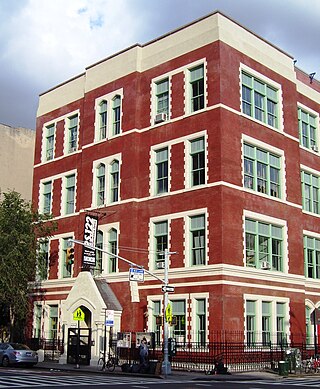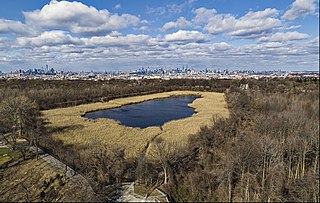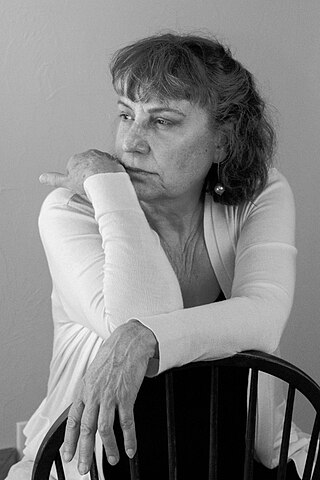Johannes Birringer is an independent media choreographer and artistic director of AlienNation Co., a multimedia ensemble that has collaborated on various site-specific and cross-cultural performance and installation projects since 1993. He lives and works in Houston and London.

Performance Space New York, formerly known as Performance Space 122 or P.S. 122, is a non-profit arts organization founded in 1980 in the East Village of Manhattan in an abandoned public school building.

Ridgewood Reservoir is a decommissioned 19th century reservoir and freshwater wetland on the border between the New York City boroughs of Brooklyn and Queens, within what is now Highland Park. Although the reservoir was originally built to secure a reliable water supply for the City of Brooklyn, it is positioned on the Queens side of the border in the neighborhood of Glendale. The reservoir and park are bounded on the north by the Jackie Robinson Parkway, on the south by Highland Boulevard, on the west by Vermont Place and on the east by Cypress Hills National Cemetery.
Danspace Project is a performance venue for contemporary dance. Its performances are held in St. Mark's Church in the East Village area of the Manhattan borough of New York City.
Charles Atlas is a video artist and film director who also does lighting and set design.
Noémie Lafrance is a Canadian-born choreographer living and working in New York since 1994. She is known for making large-scale site-specific dance performances that use the architecture of the city as the setting for her work. She is the founder and artistic director of Sens Production—a not-for-profit dance production company based in Brooklyn founded in 2001. She has received a Bessie Award and an MVPA award for her work. The Feist music video1234 that she choreographed was nominated for a Grammy.

Valda Setterfield was a British-born American postmodern dancer and actress. She was noted for her work as a soloist with the Merce Cunningham Dance Company and for her performances in works by her husband, postmodern choreographer and director David Gordon. She was described as his muse, and together they were called "The Barrymores of post-modern dance." Their son, playwright, theatrical director and actor Ain Gordon, has worked with Setterfield on a number of projects as well.
Hilary Easton is a contemporary dance choreographer, director, dancer and educator. A native New Yorker, she holds both a BFA and MFA from New York University Tisch School of the Arts. She founded Hilary Easton + Company in 1992, which has been presented at venues including American Dance Festival, Danspace Project and Dance Theater Workshop. She is on the faculty of The Juilliard School, where she teaches dance composition.
Claudia La Rocco is a poet, critic, and performer who works as a columnist for Artforum and writes about books and theater for The New York Times.
Dancenoise is an American performance art duo created by Anne Iobst and Lucy Sexton. Dancenoise entered the New York and Washington, D.C., art and club scene in 1983, performing at venues such as WOW Café, the Pyramid, 8BC, Performance Space 122, Franklin Furnace, The Kitchen, La Mama, Danspace Project, and King Tut’s Wah Wah Hut. Their work has also been presented around Europe as well as at the Lincoln Center for the Performing Arts. Dancenoise has also collaborated with other artists including Charles Atlas, Mike Taylor, Ishmael Houston-Jones, and Yvonne Meier. In addition to their work under the title Dancenoise, Iobst and Sexton, along with Jo Andres and Mimi Goese, were frequent collaborators with Tom Murrin, an East Village performance artist known for his monthly celebrations in honor of the full moon. Dancenoise is a recipient of National Endowment of the Arts Choreographic Fellowships and a Bessie Award for New York Dance and Theatre.
Emily Johnson is an American dancer, writer, and choreographer of Yup'ik descent. She grew up in Sterling, Alaska, and is based in New York City. She is artistic director of her performance company, Emily Johnson/Catalyst. Johnson is a organizer for the First Nations Dialogues New York/Lenapehoking. She has worked part-time at Birchbark Books, an independent bookstore owned by author Louise Erdrich.

Ishmael Houston-Jones is a choreographer, author, performer, teacher, curator, and arts advocate known for his improvisational dance and language work. His work has been performed in New York City, across the United States, in Europe, Canada, Australia and Latin America. Houston-Jones and Fred Holland shared a 1984 New York Dance and Performance Bessie Award for their work Cowboys, Dreams and Ladders performed at The Kitchen and he shared another Bessie Award in 2011 with writer Dennis Cooper and composer Chris Cochrane for the 2010 revival of their 1985 collaboration, THEM. THEM was performed at Performance Space 122, the American Realness Festival, Springdance in Utrecht, Tanz im August in Berlin, REDCAT in Los Angeles, Centre Pompidou in Paris, and at TAP, Theatre and Auditorium of Poitiers, France. The 1985 premier performance of THEM at PS122 was part of New York's first AIDS benefit.
Will Rawls is an American contemporary choreographer, performance artist, curator and writer based in New York City and with continuing projects in Europe. He has choreographed solo works and group works, and has danced professionally and with established dance companies. He is also one half of the performance art collaborative Dance Gang, with Kennis Hawkins.
Joan Dickinson is a contemporary American artist, writer, director, curator, and educator. Her creative practice combines visual and performance art, photography, writing, farming and environmental restoration, astrology, ceremony, and palliative care. Dickinson holds a master’s in performance from Columbia College and a doctorate (2012) from the Literary Arts program at the University of Denver.

Blondell Cummings was an American modern dancer and choreographer. She is known for her experimental choreography and was a fixture in the New York and Harlem dance scene for decades.
Michelle Ellsworth is an American dancer and performance artist, as well as a professor in the Department of Theatre and Dance at University of Colorado Boulder. Her "smart, singular" work spans live performance, video, performable websites, and drawing, employing absurdist humor, carpentry, technology, monologue, and dance. Ellsworth has received, among other awards, the Guggenheim Fellowship, the Doris Duke Impact Award, a Creative Capital Grant and a United States Artists Knight Fellowship. ArtForum has described her work as "some of the most engrossing explorations of how the body and technology coexist and collide."

Mary Overlie was an American choreographer, dancer, theater artist, professor, author, and the originator of the Six Viewpoints technique for theater and dance. The Six Viewpoints technique is both a philosophical articulation of postmodern performance and a teaching system addressing directing, choreographing, dancing, acting, improvisation, and performance analysis. The Six Viewpoints has been taught in the core curriculum of the Experimental Theater Wing within Tisch School of the Arts at New York University since its inception (1978).
Muna Tseng is a Chinese-American dancer, choreographer, author and lecturer. She has lived in New York since 1978 and in 1984 founded Muna Tseng Dance Projects in New York City. She created over 40 dance productions and performed in over 30 cities and festivals in 15 countries. Since 1990 she has been the director and executrix of her late brother Tseng Kwong Chi's photography archive. She has served for several years on the 'Current Practice' subcommittee for the annual Bessie Awards, also known as the New York Dance and Performance Awards.
Okwui Okpokwasili is a Nigerian-American artist, performer, choreographer, and writer. Her multidisciplinary performances draw upon her training in theatre, and she describes her work as at "the intersection of theatre, dance, and the installation." Several of her works relate to historical events in Nigeria. She is especially interested in cultural and historical memory and how the Western imagination perceives African bodies.
Jerron Herman is an American choreographer, dancer, performance artist, writer and a teacher for the Dream Project at National Dance Institute for children with disabilities. He grew up in California as part of a religious and art loving family. He has the movement disorder Cerebral palsy, the symptoms of which he has absorbed into his dance movements.






